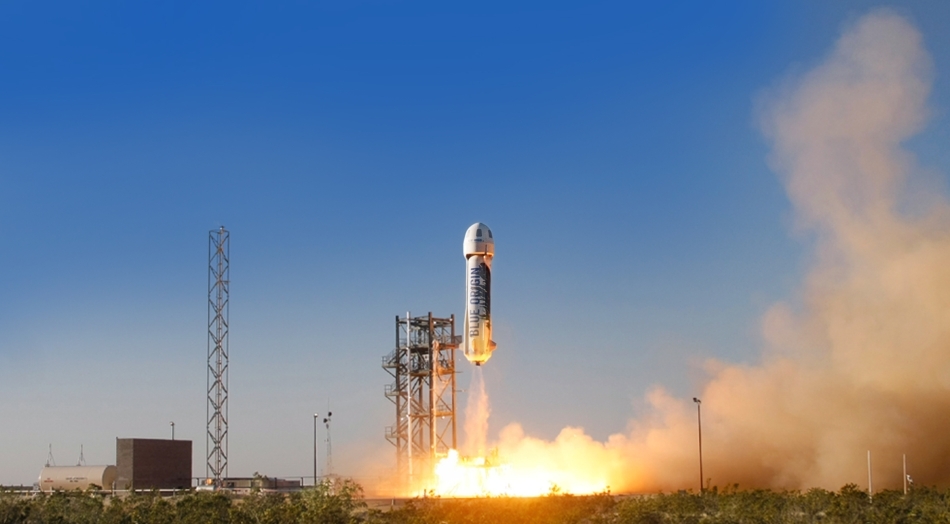Suborbital tourism: who is the first?

For the second time in the twenty-first century, news reports show trials of apparatuses for suborbital tourism. Already several companies have reached the level of launches in the foreseeable future, within a year or two. And, despite the fact that the leader in this race is now clearly visible, the experience of a decade ago shows that everything can change. Who promises us tickets for a suborbital flight?
Blue Origin - New Shepard
If you are only interested in who the leader is, here he is right away. According to the latest news, Blue Origin with the ship New Shepard confidently lead in today's race for the first suborbital tourists. They successfully survived the launch vehicle accident in the spring of 2015, when the return stage crashed, managed for the first time to make a soft landing of the rocket stage in November 2015, and for the first time successfully launched and planted an already flying stage this week.
Blue Origin already has a ship that made three suborbital flights in unmanned mode. He also successfully tested the rescue system. In sum, these facts make New Shepard the most advanced and reliable ship for suborbital tourism today. On the Blue Origin website, the feedback form already allows you to enroll in the queue of people who want to make a suborbital flight, but Blue Origin does not report any plans for 2016. Obviously, Bezos wants to please us with pleasant surprises. There is only one last milestone left - the flight of a human test. After that, you can already begin commercial launches. All this, in my opinion, with a probability of> 50% will happen this year.
Virgin Galactic - SpaceShipTwo
These people with a similar ship already won the Ansari X-Prize in 2004, a prize for two suborbital space flights in two weeks.
The ship SpaceShipOne, on which this prize was won, was handed over to the museum and decided to make an advanced version. But difficulties arose with it - the work was going on slowly, and suddenly it turned out that the engine running on SpaceShipOne could not be scaled. And in the fall of 2014, during the testing of a new type of fuel, which was supposed to ensure the operation of a more powerful SpaceShipTwo engine, the ship crashed. Did Skaled composites spend more than a year completing a second flight instance of SpaceShipTwo? and further testing is expected in February 2016.
Despite all the problems, Virgin Galactic holds the second place and may well compete for clients in suborbital tourism. Everything depends on the speed and success of the tests. In this sense, 2016 will be very important for Branson - if the new fuel turns out to be successful, after several test flights it will be possible to start riding tourists, since Virgin Galactic already has customers. Tests can be done in 2016, and the first tourists, if all goes well, will be able to go on a flight already in 2017.
XCOR Aerospace - Lynx
Developed since 2003, the Lynx suborbital vehicle has matured before the start of flight tests, which are scheduled for the second quarter of 2016. A prototype ship called Rocket Racer was successfully tested in 2008.
The project uses a scheme that is not very efficient in terms of fuel with a single rocket engine and start on it from the ground. As expected, Lynx will be able to carry just one suborbital tourist, and ticket prices have already risen to $ 150,000. However, successful prototype testing gives the XCOR Aerospace a good chance. By the way, the same company, in collaboration with NASA, makes methane engines, and a successful private space enterprise may well grow out of it.
Another interesting technical feature is that the XCOR Aerospace rocket engines do not use fuel pumps, but conventional compressors. Such a solution may well take root in cases where the simplicity and cheapness of a rocket engine will be more important to engineers than its efficiency.
Airbus - Airbus Defense and Space Spaceplane
Large companies also decided not to miss the potentially profitable suborbital tourism market. Aircraft-building giant Airbus, without much PR, has been conducting a suborbital spacecraft project for several years. A ship the size of a business jet uses conventional turbojet engines for takeoff and climb, and then jumps into space on a rocket engine:
The most recent project data is a throw test of an unmanned scale model in 2014:
Coppenhagen suborbitals
Well, in contrast, it is worth recalling the existence of Danes who, at the end of the zero, experimented with the Tycho Brahe capsule, which, in theory, can grow into an apparatus for suborbital tourism. Alas, during the 2011 tests, the rocket drowned in the Baltic Sea, and the capsule hit the water with an overload of 26 g due to parachute failure. The camera in the capsule survived and was picked up:
Valorous Danes do not give up, they try different systems (I recommend looking at testing a parachute system with a live parachutist) and now they are making the Nexø rocket, the test flight of which was postponed from 2015 to 2016. Before the flights of tourists, at best, they will be several years old, but the efforts and achievements of the Coppenhagen Suborbitals still delight.
If you have an extra 100-200 thousand dollars and a desire to make a suborbital flight, I would recommend Blue Origin. Well, if you don’t have such an amount, stay tuned, I think this year will please us with new and interesting videos from the tests, and who knows, maybe even from the flights of real suborbital space tourists.
Related Content : Private Space
